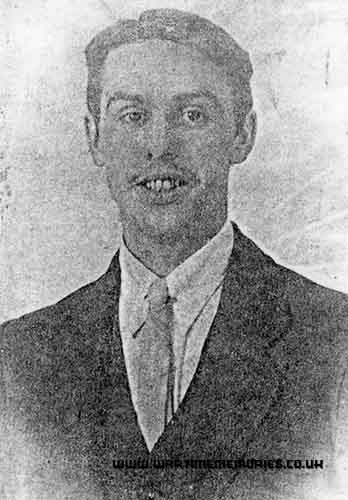Additions will be checked before being published on the website and where possible will be forwarded to the person who submitted the original entries. Your contact details will not be forwarded, but they can send a reply via this messaging system.
please scroll down to send a message
Pte. Samuel Mallet Makepeace
British Army 4th Batt. Durham Light Infantry
from:Cemetery Road, Gateshead
(d.6th Aug 1917)
Samuel Mallet Makepeace was 5’6†tall, weighed 125lbs and had a 35†chest, excellent vision, and the sparkling blue eyes that only appear once or twice in each generation of the Makepeace family. By all accounts, he was quite popular with the ladies but eventually got engaged to Mary Byrne of 45 Northbourne Street, in July 1914. Shortly after this date, he converted to Roman Catholic to the horror of his parents who disowned him and turfed him out of the family home. He moved in with Mary (who was already pregnant with his child) and her family at Northbourne Street. On 26th September, 1914, he married Mary at St. Joseph’s Roman Catholic Church in Gateshead and they moved to 69 Arthur Street, just off Prince Consort Road. Their daughter, Elizabeth Teresa, was born on 9 April 1915.
On 3 December 1915, Samuel enlisted at Newcastle and was posted to the Army Reserve as he was in a reserved occupation however on 2 November 1916, he received correspondence releasing him from his work with the railway and ordering him to take his place in the Army. He was posted on 17 November to the 4th Batt. Durham Light Infantry (DLI) as Private 39419 S Makepeace and the following day departed to Seaham Harbour Training Camp.
During his time there he was reprimanded twice – the first time on 8 December 1916 for being in the canteen during parade hours (for which he was fined 3 days loss of pay) and the second on 2 February 1917 for overstaying his embarkation leave by 11 hours – he had to forfeit two days leave for this. I wonder if he might have overstayed for longer had he known that this would be the last time he would see his wife and daughter?
The entire Battalion left Seaham Harbour by train on 8th February bound for Folkestone where they arrived the following day and boarded the SS Victoria which took them to Boulogne where they disembarked the following morning. Four days later, Samuel and his comrades were posted to the 14th Batt. DLI, Officer Commanding 35th Infantry Batt. at Etapes. They did see action there but very little is recorded of the minor skirmishes that took place at that time. On 5 March, orders were received that the men were to be re-posted to the 15th Batt. DLI and they undertook a four-day march joining the Battalion on the battlefield immediately they arrived on 9 March.
Samuel was caught in a gas attack on 13 April 1917, during the Battle of Arras and was moved to the VII Corps Main Dressing Station at Boisieux-au-Mont, two days later. Considering that he was unlikely to recover so near to the battlefront, he was moved to the 43rd Casualty Clearing Station on 29 April. But he did recover and returned to the Officer Commanding 35th Infantry Battalion at Etapes on 26th May, re-joining his regiment on 2nd June and arriving back at the frontline on 10th June.
On 4th August 1917, he was badly wounded – his legs were blown off in a shell attack by the Huns eager to get back the two or three yards of territory that they had lost. Samuel died from his wounds at the 20th Casualty Clearing Station on 6 August 1917 and was buried in the Bucquouy Road Cemetery near the village of Ficheux. In 1920, following the re-organisation of War Graves, the Commonwealth War Graves Commission erected a headstone to Samuel’s memory marking the spot where his grave now lies. This headstone records the date of his death incorrectly and an appeal has been made for a correction.
Meanwhile back in England… Samuel’s wife, Mary and daughter Elizabeth Teresa, moved from 69 to 71 Arthur Street in 1917 and a little later that year to 19 Margaret Street, Washington. The War Office, upon receiving a telegram of Samuel’s death, telegraphed the Infantry Battalion HQ at York who duly issued the telegram to Mary. I was initially very surprised to find that this has survived and is in the National Archive but it made sense when I read the next document that advised that the telegram had not been delivered as she had moved away and not provided a forwarding address. It was not until February 1918 that Mary must have realised that Samuel was dead and contacted the War Office. She made a claim for and eventually received his medals (the British War Medal and the Victory Medal) and also made a claim for a widow’s pension for her and Elizabeth. To get the pension, she had to provide proof of family connection and here she became a bit stuck.
Following Samuel’s conversion to the RC faith, his family had disowned him and Mary was not made welcome in the family home. As the years had elapsed she had probably forgotten Sam’s parents and brothers and sisters and those she could recollect and their addresses, she got confused on the official claim form. Nevertheless, she was granted a pension of 18s 9d per week. She later lost this when custody of their child was passed to her mother-in-law. What became of Mary we do not know. Elizabeth Teresa was sent to a Catholic Childrens' home in 1928 where she remained until her death in 1999 - unknown to any family born after WW1.

.jpg)
.jpg)
.jpg)
.jpg)